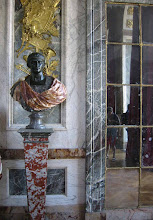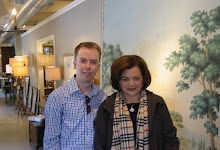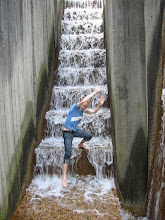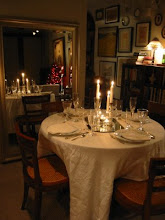
Down an allee of ancient trees in Bucks County lies a ancient looking fairytale
arts and crafts castle. This is the last thing you would expect to find in rural Pennsylvania, more fitted to the English countryside perhaps.

More bizarre however is the material: concrete. Much like his museum, the
Mercer, Henry Chapman Mercer built his own house between 1908 and 1912 out of this versatile material. While not quite to the extent as the museum, the house still incorporates concrete in the roofs (mostly covered in clay tiles made at the adjacent factory), dormers, chimneys, floors, walls and ceilings.

Light was Mercer's key concern. Over 200 windows were incorporated into the facade in all shapes and sizes: Most are operable. As a testament to the design, even on cloudy days candlelight (or electric lights) are barely needed unlike the castle's European precedents.

The house is truly quirky and enchanting. As it's the brainchild of Mercer, I would expect him to be a fascinating character as well: I'd love to pick his brain over a meal!

Color is greatly incorporated into the building, unlike his later museum. While most of the interior pastel colors have faded over the years (another testament to the amount of light received) the window sills and doors are still vibrant shades of red and yellow.

Mercer employed a surprisingly small number of employees in the building of his structures, whom he would personally train. He was a great employer in that he loved that they all took pride in their work and treated them well. Many are commemorated throughout the space, such as the work horse (literally) Lucy; He created a wind vane in her honor.

The house is truely an amalgamation of styles and shapes - a working dictionary of forms. From one angle it may appear one way and then after turning the corner, the structure takes on an entirely different shape.

Here you can see some examples of the concrete windows - inoperable of course. They were created from the moulds of operable antique wood windows, with the glass set into wet concrete. An unusual technique and one which works well obviously as the windows are original to the structure.

Mercer was lucky to have passed away at his beloved home in 1930. His housekeepers lived in the house till their deaths many years later at which point it became a museum. Of course, stories are passed around about the castle being haunted, but I had no such experience as I did at the nearby
Phillips Mill!

Don't miss the interiors tomorrow!
 The interiors of Fonthill are probably even more fascinating than the exterior; they were the driving force behind the architecture afterall! Above you see some of the remaining color in one of the bathrooms. Originally the house was filled with many bright and pastel colors (some might say garish). Mercer was a collector of many things, including prints, which are displayed everywhere he could find wallspace including over the sink!
The interiors of Fonthill are probably even more fascinating than the exterior; they were the driving force behind the architecture afterall! Above you see some of the remaining color in one of the bathrooms. Originally the house was filled with many bright and pastel colors (some might say garish). Mercer was a collector of many things, including prints, which are displayed everywhere he could find wallspace including over the sink! Tiles by the Moravian Tile works are found everywhere - floors, ceilings and fireplaces. Mercer used the house as his laboratory and tile museum, bringing potential clients to see different examples and even allowing them to stay overnight. I especially love these tiles set into concrete on this chimney breast; Mercer was inspired by 16th century Italian fabric in this instance. Notice the Wedgwood Portland vase on the upper left-hand shelf.
Tiles by the Moravian Tile works are found everywhere - floors, ceilings and fireplaces. Mercer used the house as his laboratory and tile museum, bringing potential clients to see different examples and even allowing them to stay overnight. I especially love these tiles set into concrete on this chimney breast; Mercer was inspired by 16th century Italian fabric in this instance. Notice the Wedgwood Portland vase on the upper left-hand shelf. In Mercer's private study, you can see how much the room was used. The leather on the sofa is worn OUT, which I love to see. Books line this room (as elsewhere) as do ancient pottery examples sourced from all over the world. The wood paneling was reclaimed from many sources, much of it from old doors; Mercer was nothing if not resourceful. This was one of the few rooms with wood flooring and where he would have spent much of his time; amazing views out the huge corner windows of the garden.
In Mercer's private study, you can see how much the room was used. The leather on the sofa is worn OUT, which I love to see. Books line this room (as elsewhere) as do ancient pottery examples sourced from all over the world. The wood paneling was reclaimed from many sources, much of it from old doors; Mercer was nothing if not resourceful. This was one of the few rooms with wood flooring and where he would have spent much of his time; amazing views out the huge corner windows of the garden. The Columbus room was dedicated to the discovery of the New World and the tiles are all about this event. The tiles were set into the concrete formwork as the ceiling was being poured and were not applied afterwards; an innovative technique!
The Columbus room was dedicated to the discovery of the New World and the tiles are all about this event. The tiles were set into the concrete formwork as the ceiling was being poured and were not applied afterwards; an innovative technique! The interior photographs are by Bjorn Wallander and were featured in the Sept. 2007 Martha Stewart Living magazine. Thanks to Kathy of Hearth and Hedgerow Ltd. for helping me gather some information. Check out her blog!
The interior photographs are by Bjorn Wallander and were featured in the Sept. 2007 Martha Stewart Living magazine. Thanks to Kathy of Hearth and Hedgerow Ltd. for helping me gather some information. Check out her blog! Down an allee of ancient trees in Bucks County lies a ancient looking fairytale arts and crafts castle. This is the last thing you would expect to find in rural Pennsylvania, more fitted to the English countryside perhaps.
Down an allee of ancient trees in Bucks County lies a ancient looking fairytale arts and crafts castle. This is the last thing you would expect to find in rural Pennsylvania, more fitted to the English countryside perhaps. More bizarre however is the material: concrete. Much like his museum, the
More bizarre however is the material: concrete. Much like his museum, the  Light was Mercer's key concern. Over 200 windows were incorporated into the facade in all shapes and sizes: Most are operable. As a testament to the design, even on cloudy days candlelight (or electric lights) are barely needed unlike the castle's European precedents.
Light was Mercer's key concern. Over 200 windows were incorporated into the facade in all shapes and sizes: Most are operable. As a testament to the design, even on cloudy days candlelight (or electric lights) are barely needed unlike the castle's European precedents. The house is truly quirky and enchanting. As it's the brainchild of Mercer, I would expect him to be a fascinating character as well: I'd love to pick his brain over a meal!
The house is truly quirky and enchanting. As it's the brainchild of Mercer, I would expect him to be a fascinating character as well: I'd love to pick his brain over a meal! Color is greatly incorporated into the building, unlike his later museum. While most of the interior pastel colors have faded over the years (another testament to the amount of light received) the window sills and doors are still vibrant shades of red and yellow.
Color is greatly incorporated into the building, unlike his later museum. While most of the interior pastel colors have faded over the years (another testament to the amount of light received) the window sills and doors are still vibrant shades of red and yellow.
 The house is truely an amalgamation of styles and shapes - a working dictionary of forms. From one angle it may appear one way and then after turning the corner, the structure takes on an entirely different shape.
The house is truely an amalgamation of styles and shapes - a working dictionary of forms. From one angle it may appear one way and then after turning the corner, the structure takes on an entirely different shape. Here you can see some examples of the concrete windows - inoperable of course. They were created from the moulds of operable antique wood windows, with the glass set into wet concrete. An unusual technique and one which works well obviously as the windows are original to the structure.
Here you can see some examples of the concrete windows - inoperable of course. They were created from the moulds of operable antique wood windows, with the glass set into wet concrete. An unusual technique and one which works well obviously as the windows are original to the structure. Mercer was lucky to have passed away at his beloved home in 1930. His housekeepers lived in the house till their deaths many years later at which point it became a museum. Of course, stories are passed around about the castle being haunted, but I had no such experience as I did at the nearby
Mercer was lucky to have passed away at his beloved home in 1930. His housekeepers lived in the house till their deaths many years later at which point it became a museum. Of course, stories are passed around about the castle being haunted, but I had no such experience as I did at the nearby  Don't miss the interiors tomorrow!
Don't miss the interiors tomorrow!





 My favorite part of the house is the bell mounted to the side of one chimney; To call everyone in for meal times perhaps? Now thats some technology (but I'd rather have A.C.)!
My favorite part of the house is the bell mounted to the side of one chimney; To call everyone in for meal times perhaps? Now thats some technology (but I'd rather have A.C.)!










































.JPG)







































































